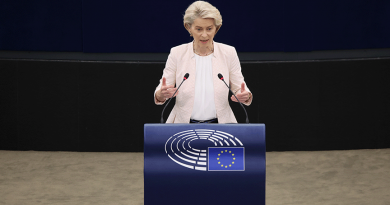Has the DMA got it wrong on app stores?
Bertin Martens is a Visiting Fellow at Bruegel
Apple’s iPhone and Google’s Android mobile operating system dominate the smartphone market. The two companies also control the app stores consumers use when downloading apps for use on their smartphones.
iPhone users can download apps only from the Apple app store. Android phones, meanwhile, allow ‘sideloading’ of apps from stores other than Google Play. For example, handset manufacturers can install their own app stores on phones. However, these alternatives are rarely used.
As a result, Apple and Google are firmly entrenched as app gatekeepers. They charge app developers store entry fees and a 15%-30% fee on in-app sales of digital services, such as subscription renewals and additional features in games, though there are no fees on in-app sales of physical goods and services, such as e-commerce products or transport services.
Some popular app developers, including Spotify music streaming and Fortnite games, have complained about these high fees. They say they harm consumers by increasing prices for in-app services. They want to bypass the incumbent stores with their own app stores and payment services.
The European Union’s Digital Markets Act (DMA), which will apply from 2 May 2023, buys into these arguments. It seeks to erode the market power of app stores and to increase competition in app markets.
This will be done, first, by a requirement that consumers should be able to download apps from competing app stores. Second, consumers and app developers should be able to use competing payment service providers for in-app sales.
These obligations together are intended to stimulate price competition and enable app developers to circumvent the high fees Apple and Google charge on in-app sales.
The gravity force of network effects
But there are reasons to doubt whether these provisions will work. Google already complies with the first obligation because Android phones allow sideloading from other stores. But, because of network effects, this theoretical choice makes little difference.
App developers want to be where consumers are, and vice versa, meaning that developers must be present in both the Apple and Google Play stores, while consumers have no incentive to switch to other stores because it would not give them access to more apps.
A look at the Chinese Android app market gives a sense of the importance of the network effect. Google withdrew the Google Play store and Google Search from China when it came under censorship pressure (Apple has no search engine and accepted app store content restrictions imposed by Chinese authorities).
The effect in China was to remove the dominant app store and open up competition between hundreds of smaller Android app stores. Under the DMA, this might be considered a successful achievement of contestable markets, but in fact the Chinese experience has been higher search costs among fragmented stores and less security for consumers, without evidence of more price competition.
More fragmentation also means higher development and marketing costs for app developers, who need to be present in many stores. Nobody has gained from eliminating network effects around the Google Play store.
Regulators need to consider the whole rather than the separate parts, or risk losing the network benefits in the bid to tackle monopolistic pricing behaviour
Consumers might be attracted by specialised app stores. Large game developers such as Fortnite, for example, might be able to generate sufficiently strong network effects around their own app stores because they have a large and loyal consumer bases, and because their app stores cater to several types of game devices, not only smartphones.
However, these popular game developers are unlikely to want to share their stores with their competitors. This would result in fragmentation of the market for games and the unwinding of network effects. Ordinary apps, meanwhile, are unlikely to attract enough consumers to make their own stores viable. Network effects will force them to stay in the main Google Play and Apple app stores.
Network effects are also relevant for payment services. Via Apple Pay, consumers can cover all payments in all their iPhone apps, whereas separate app-by-app registration and payment would be onerous. Banks and credit card issuers will also want to benefit from these network effects.
So while app-store operators may exploit their power to increase prices, consumers and app developers also benefit from each other’s massive presence. A monopolistic price enables app-store operators to monetise and appropriate part of these consumer benefits.
As long as consumers consider that network-effect benefits exceed the price they pay, including switching costs, they will stay with the dominant app store and payment service. The DMA tends to ignore the benefit side. It bets that price competition may overcome the gravity force of network effects.
Some consumers might indeed be prompted by lower prices to step outside the app stores and use another payment service. A newspaper app for example, could offer a subscription discount if payment is done through the newspaper’s own website and payment service rather than through the app. The newspaper would then avoid the app-store operator’s 15% fee. But how much of this 15% price margin would the newspaper be willing to share with subscribers?
Ex-ante versus ex-post measures
The idea of taming the big app stores also faces other difficulties.
Regulators could try to intervene in the pricing of access to stores. But app-store operators can retaliate by charging higher fees on alternative payment channels. That is what happened in the Netherlands, after the Dutch competition authority judged that Apple should allow alternative payment channels to increase price competition.
Apple lowered the fee on in-app purchases from 30% to 27%, but developers now pay a separate 3% fee on the in-app payment service. Even if the fee on in-app purchases went to zero, Apple has many other options to recuperate revenue.
The DMA prohibits ‘anti-circumvention’ measures that make the exercise of users’ rights unduly difficult. For instance, restrictions imposed by app-store operators on app developers that prohibit the advertising of alternative payment services inside an app are likely to be considered as anti-circumvention measures.
However, there are loopholes. For example, the DMA allows app-store operators to protect the integrity and security of apps and hardware. Apple and Google can justifiably claim it is costly to run app stores and operating systems, and to ensure consumers can enjoy secure and high-quality apps. It would be much harder to argue that such alternative fees are anti-circumvention measures.
This is where the proportionality principle comes into the debate: are these fees proportionate to the service provided? That is where economics may slip back into the DMA. The DMA is deliberately designed to remove economic efficiency considerations from the implementation of the app-store obligations.
Competition authorities are too frustrated with endless economic arguments with large platforms. The ex-ante DMA obligations are designed as a short-cut to gain time. But the short-cut may turn out to be a dead-end.
Alternative fees could spark a classic economic debate about reasonable fees for app-store services: 15%, 5%, or some other number? Going down that road is likely to end up with price regulation, similar to the telecoms sector, where network access prices are subject to regulation.
Some argue that app stores, like telecom networks, should indeed be treated like public utilities and regulated accordingly. However, creating a precedent with app stores could soon spread to other core platform services operated by DMA gatekeepers. Policymakers are unlikely to want to go that way.
Alternative approaches
Full implementation of the DMA is no guarantee that the app-store obligations will achieve the objectives of an open and contestable app-services market. Regulators need to consider the whole rather than the separate parts, or risk losing the network benefits in the bid to tackle monopolistic pricing behaviour.
The DMA app-store obligations reflect old standards in competition policy, such as price competition and the idea that small is beautiful when it comes to market shares. But in a digital platform economy, big market shares, because of network effects, also have their beautiful side.
Policymakers could start by recognising the benefits of network effects for developers and users of apps and payment services. That would create space for a comparison of the costs of monopolistic behaviour with the benefits of network effects.
This cost-benefit analysis may not be admissible yet in the dialogue, foreseen in the DMA, between authorities and gatekeepers. That dialogue is supposed to focus only on the implementation of the obligations, not on the effectiveness of the obligations.
While this distinction may be a bit artificial, the European Commission may want to play it hard in the early phases of implementation. It will however be forced to reconsider that position if the results remain unconvincing.
The DMA allows for a revision of the obligations, following a market investigation of their effectiveness, by delegated act and without changes to the DMA regulation itself. That is where economic cost-benefit analysis and evidence will become unavoidable.
Economic analysis will necessarily take into account the multi-sided market nature of app stores, including the costs and benefits of network effects that are an integral part of multi-sided markets.
The DMA gives competition authorities deep access to gatekeepers’ internal data. That will facilitate economic analysis and enable them to make more informed judgements about the costs and benefits of various policy options. Any revision of obligations should avoid the costs of a partial or full unwinding of network effects and app market fragmentation.
This article was originally published by Bruegel.




